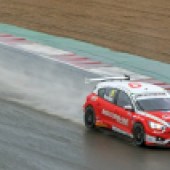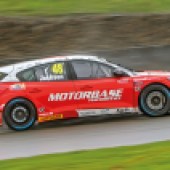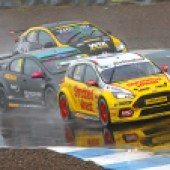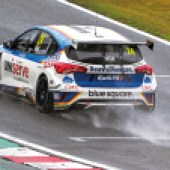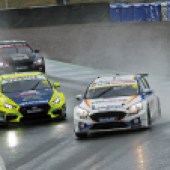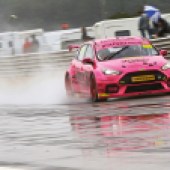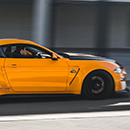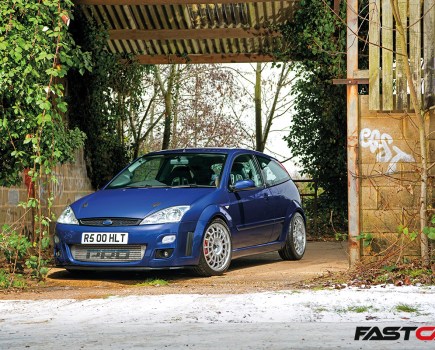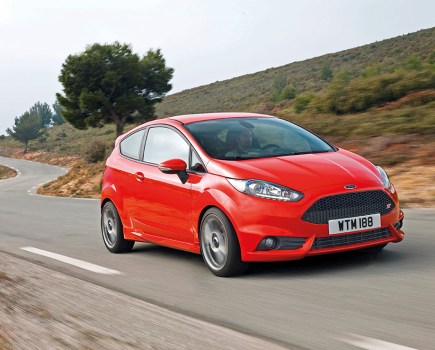Wet track days in the UK don’t have to be a complete wash out… here are some pro tips for wet weather track driving to ensure you can pedal safely.
Guide from Fast Ford magazine. Words: Alex Nevill. Photos: Motorbase performance.
Wet weather races are known in motorsport as the great leveller; these are the conditions in which the technical abilities of the car take a back seat and the driver can really make the difference. Driving on track in the rain is a real challenge for drivers of all levels, whether you’re a seasoned pro or a complete novice. There’s no better test of your car control and concentration than on a wet circuit, and here are our top tips to make you faster in low-grip conditions.
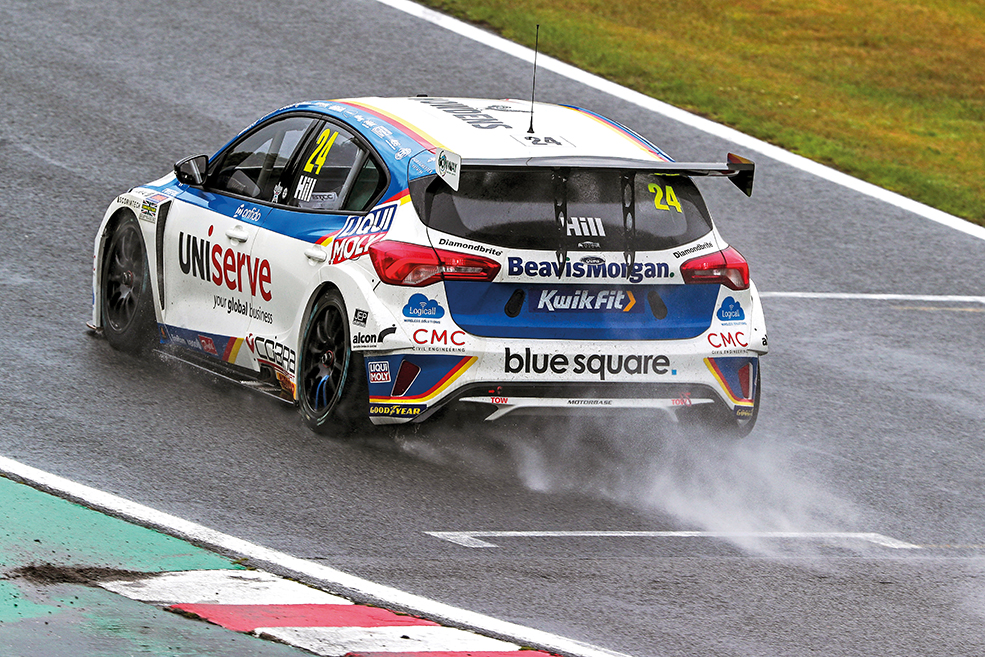
Braking techniques are similar to dry conditions, but you need to be aware of the increased braking distances required
Wet weather track driving: Braking
It’s important that your braking technique remains broadly like what you’d do in the dry. You still need to be hitting your threshold at the start of the braking zone so that you can bleed off the brakes on the approach to the corner. The threshold itself is likely to be lower than it is in the dry, of course, as you have less grip available.
If your car has ABS fitted then that will give you a good indicator if you ever stray beyond the threshold, and if you don’t then a slightly more progressive application of the brakes might help. You’ll still need to get to your threshold at the start of the braking zone, so treat your application the same way you do with the throttle on the exit where you try to get the power down smoothly but quickly.
If you can get the technique right, you’ll still hit the threshold early enough in the braking zone, but any lock-ups will be smaller and, therefore, more manageable. It’s easy to be too cautious on the brakes in the wet; it’s important to remember that a lock-up early in the braking zone is much easier to correct than going into the corner too hot because your brake pressures were too low.
In the wet, you often find that there’s less grip on the dry line where the rubber’s been laid down, so for any big braking zones (mainly hairpins), it’s worth moving a car’s width off the usual line before you hit the brakes. Towards the end of the braking zone, you’ll then want to move back out to the dry line so that you don’t make the corner tighter than it needs to be.
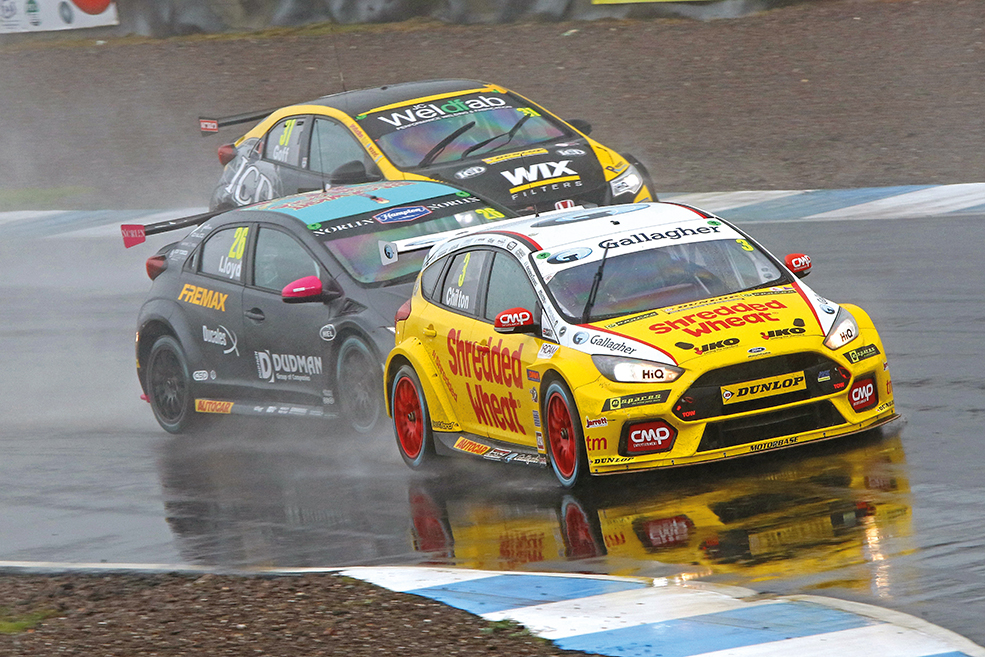
Try to avoid the kerbs in the wet
Turning
Your lines through a corner in the wet are usually a compromise of three factors: corner speed, distance, and exit speed.
To carry the corner speed, you need grip and – as with the braking zones – you’re likely to find the grip away from the typical dry line, which means going around the outside of the corner.
Aside from more grip, the wider line around a corner usually results in a more stable car, as you’re applying less steering lock and therefore you’re asking less of the tyres and the car in general. More stability makes it easier to consistently carry the speed through the corner.
The wide lines can feel quite daunting to start with as you’re closer to the gravel and the barriers. The key thing to remember here is that the less steering lock you put in, the less likely you are to generate understeer or oversteer that could put you off the circuit.
So, although you’re closer to the barriers, you’re arguably reducing your risk of hitting them with the wide lines. On the flip side, there’s a smaller margin for error when you’re already on the edge of the circuit.
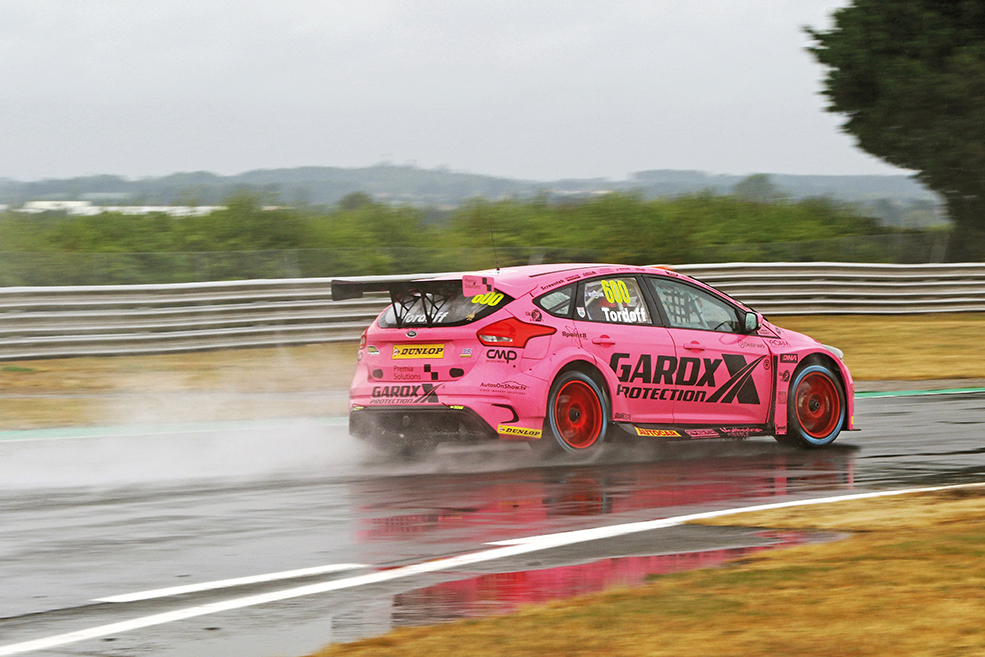
The wide line is the easiest way to carry the speed through the corner, but of course, it’s also the longest route around the corner. For corners of a more acute angle such as Oggies at Snetterton or Graham Hill at Brands Hatch, for example, the best line through the corner is often the middle of the circuit – a car’s width off the dry line.
This will still give you the benefits of the wide line while also cutting some distance from the circuit. The other option with a corner like this is to try to hook the car on the inside kerb. This will be the shortest distance through the corner but getting the car to the kerb will mean slowing it down a lot more than you would on a wider line, and the car is also likely to understeer on exit due to the tighter line, which makes it much harder to get the power down.
If nothing else, it’s a line that will be very hard to pull off consistently, but it does have its benefits at corners such as Nelson at Snetterton, where the corner’s too tight for there to be a wide wet line.
When turning into a medium-high-speed corner it’s good to use what’s called a ‘balanced throttle’. By this, we mean a small amount of throttle; not enough to make the car accelerate noticeably but enough to change the balance of the car slightly. A small sliver of power as you turn into the corner will keep a bit of weight on the rear of the car, which (particularly on a front-wheel-drive car) will make the rear feel more stable… And if it does still slide, you’ve already begun the process of saving a spin by being back on the power nice and early.
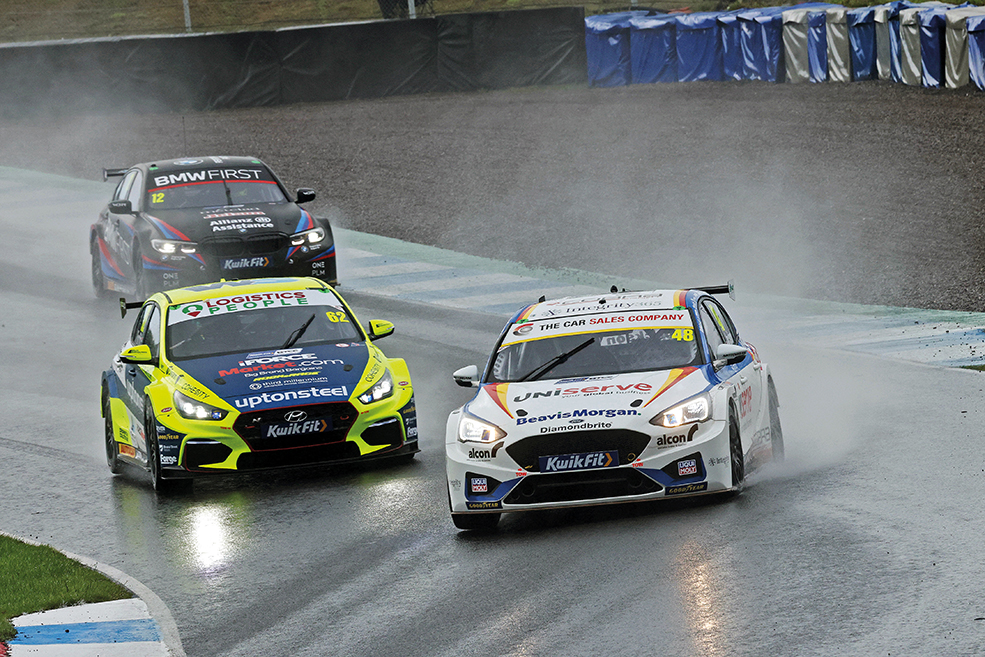
Straightening the corner as much as possible will allow you to get on the power earlier
Corner exit
Through most medium and fast corners, the exit will just be a natural evolution of your line through the turn. But around a hairpin, you’re able to find more speed on the exit of the corner by squaring-off the bend.
To do this you start the corner with a wide line before cutting back for a very late apex. The benefits are twofold: first, it keeps you off the dry line on the exit, which should give you more grip and therefore more traction; and secondly, it means the wheels are straighter on the exit, which reduces the strain on the front tyres.
Accelerating and turning on the exit of a hairpin will usually generate wheelspin and therefore understeer. Taking some of that lock off means you’re less likely to suffer from either.
A good example of this line would be Agostini at Snetterton. In the dry, you’d usually apex about halfway around the inside kerb, whereas in the wet you’re better off holding out wide at the entry and aiming to apex towards the end of the kerb for a straighter run onto the next straight.
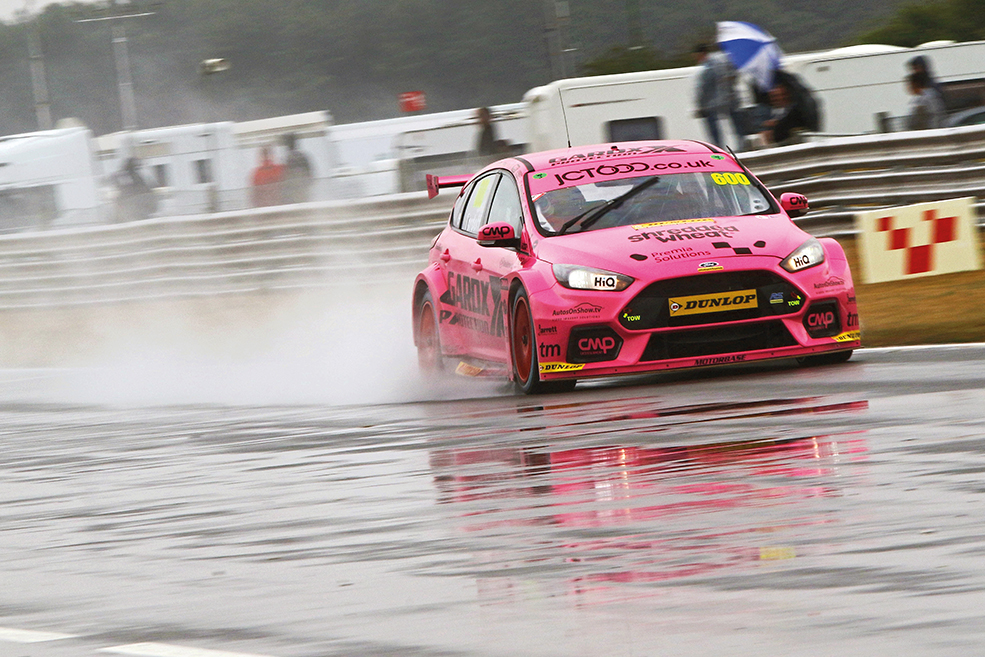
Be aware of other cars around you. Even a bright pink RS can be difficult to spot in heavy spray
General tips for wet weather track driving
- Watch for track evolution – Even in the dry, you should look at a racetrack as a living thing, constantly evolving throughout the day as the conditions and the grip levels change. Never is this truer than in the wet when the conditions, and therefore the track, can change with every lap. If the rain is heavy, watch out for rivers forming on the track that could cause aquaplaning, and if the rain has eased off or stopped, start looking for the driest parts of the track for more grip. Keep an open mind on your racing lines, and don’t be afraid to experiment a little.
- Remember the basics – The smooth driving and respect for vehicle dynamics that we talk about in the dry are even more important in the wet, as the grip level is lower and you’re therefore a lot closer to the limits of the car and the tyres. Smooth and predictable inputs will usually lead to smooth and predictable responses from the car, but on the flip side, aggressive inputs lead to aggressive responses.
- Dry your feet before touching the pedals – Wet shoes can slip off pedals very easily. Once you’re in the car, make sure you use a cloth to dry the soles of your footwear before they touch the pedals. That’s some advice that comes from experience.
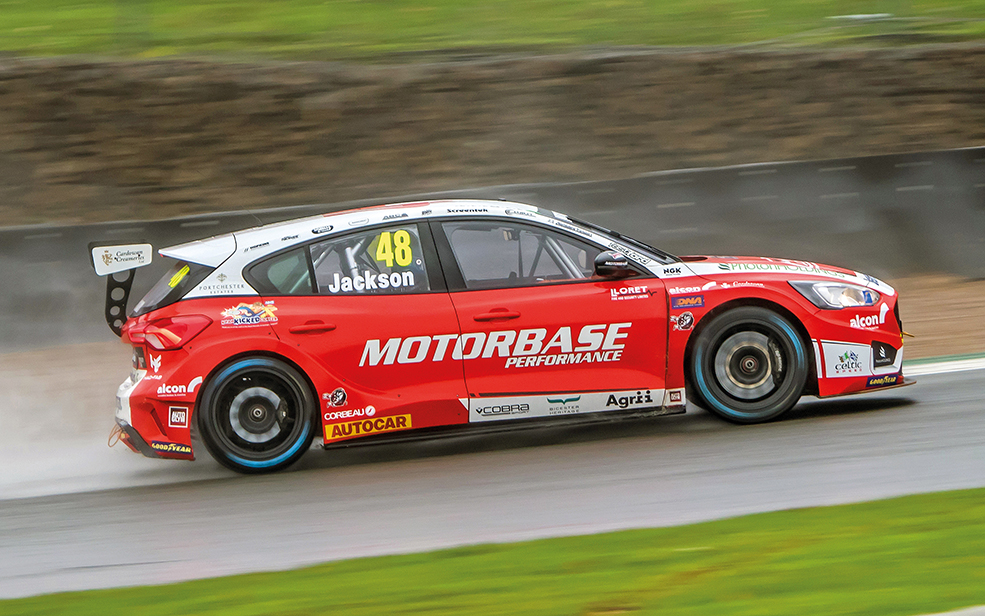
Car setup tips for wet weather track driving
- Increase tyre pressures – Most race cars will swap from slicks to dedicated wets with optimal pressures for each, but track day fans running on track day cut-slicks or grippy road tyres will need to increase tyre pressures. The colder conditions and lower grip levels mean the pressures won’t increase as much as they would in the dry, so to compensate you should increase the starting pressures to ensure the tyre is operating at optimal pressure on track.
- Soften damping settings – If you have adjustable dampers, winding back a few clicks will give a softer feel and allows for better weight transfer in low-grip conditions.
- Soften roll bar settings – In the wet you’ll be going slower, so won’t need such stiff roll bar settings; in fact you’ll want to increase body roll a little in the search for more grip. If you have anti-roll bars front and rear, then soften the driven axle more than the other to give more grip on corner exits. If you don’t have adjustable roll bars, sometimes disconnecting altogether is better than leaving particularly stiff roll bars attached.
- Reduce camber – Dry camber settings can be too aggressive for the wet. Reducing the camber angle will allow for the optimum contact patch between the tyre and the track.
- Increase wing angles – If you have adjustable aero devices like wings, then increasing the angle of attack to give the car more downforce will add stability in low-grip conditions.


